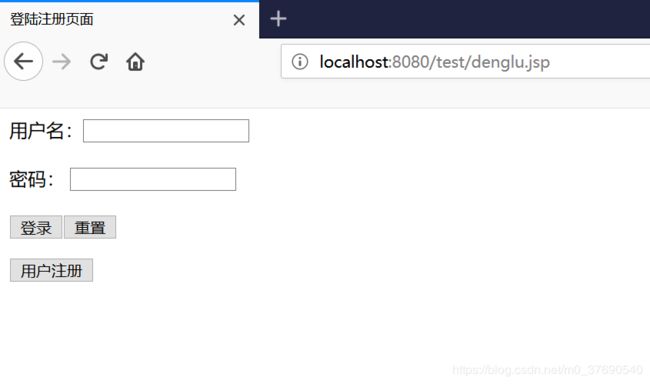Java Web-1 制作简单的网页
制作简单的网页
- 一、网页主要功能
- 二、涉及到的知识点
- 三、搭建步骤
- 1. 首先打开mysql数据库,新建一个数据库test,然后生成对应的表结构
- 2. 打开Eclipse新建一个web项目
- 3. 在webroot下的WEB-INF下的lib中导入mysql和tomcat的驱动jar包
- 4. 建立对应的包结构
- 5. 在filter下新建一个EncodingFilter用来解决中文字符集乱码,它需要实现Filter接口,并重写doFilter函数。
- 6. 到web.xml下进行对EncodingFilter相应的配置
- 7. 在util下新建一个DBconn类用来处理对数据库的连接操作
- 8. 在entity下新建一个User实体类
- 9. 在dao下新建一个UserDao接口,以及对应的方法实现类
- 10.在servlet下创建DengluServlet用来实现对用户登录的操作
- 有两点要注意的地方:
- 1:getParameter与getAttribute两者的区别
- 2:转发与重定向的区别
- 11. 在servlet下创建一个ZhuceServlet用来实现用户注册的操作
- 12. 在servlet下创建SearchallServlet用来返回数据库中所有用户信息
- 13. 在servlet下创建DeleteServlet用来删除用户操作
- 14. 在servlet下创建UpdateServlet操作用来更新用户信息
- 15. 配置servlet
- 16. 新建jsp页面
- 17.补充jar包
- 结束语
本案例使用 Servlet + JSP 制作,用Eclipse和MySQL数据库进行搭建网页,期间详细介绍了搭建过程及知识点。
(代码下载地址请到文末)
一、网页主要功能
- 用户注册
- 用户登录
- 用户列表展示
- 用户信息修改
- 用户信息删除
二、涉及到的知识点
- JDBC
- Servlet
- 过滤器
- EL与JSTL表达式
三、搭建步骤
事先配置好jdk、tomcat
1. 首先打开mysql数据库,新建一个数据库test,然后生成对应的表结构
CREATE TABLE `user` (
`id` int(11) NOT NULL auto_increment,
`name` varchar(255) NOT NULL,
`pwd` varchar(255) NOT NULL,
`sex` varchar(255) NOT NULL,
`home` varchar(255) NOT NULL,
`info` varchar(255) NOT NULL,
PRIMARY KEY (`id`)
) ENGINE=InnoDB AUTO_INCREMENT=5 DEFAULT CHARSET=utf8;
INSERT INTO `user` VALUES ('3', '123', '123', '123', '123', '123');
INSERT INTO `user` VALUES ('4', '123123', '123123', '男', '北京', '123123');
新建查询,输入语句,运行,就可以很快生成一个包含数据的数据表了。
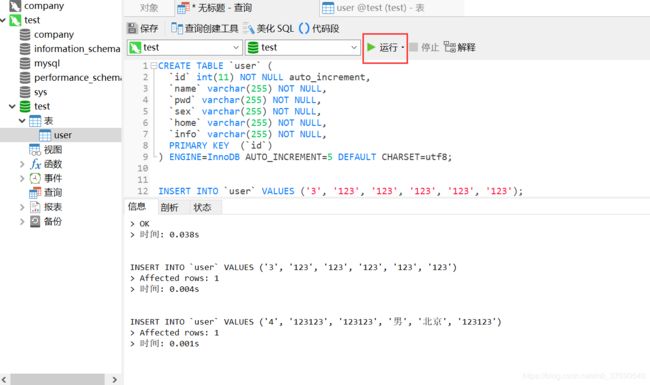
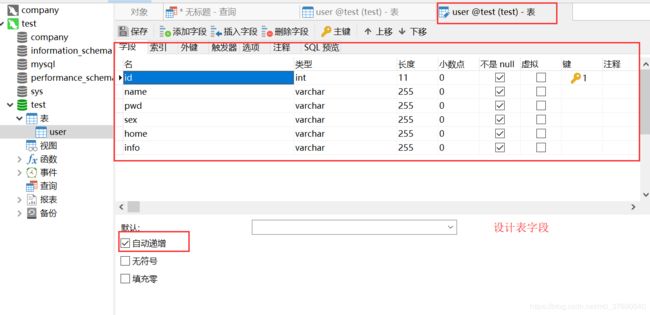

这里使用到了navicat for mysql ,这是一种MySQL的图形界面化工具,后期可以非常方便的操作数据库。
2. 打开Eclipse新建一个web项目
3. 在webroot下的WEB-INF下的lib中导入mysql和tomcat的驱动jar包

jsp-api.jar和servlet-api.jar是驱动tomcat;
mysql-connector-java-5.1.34.jar是驱动MySQL;
再右击项目名,选择“Build Path”→“Configure Build Path…”导入lib里面的3个jar
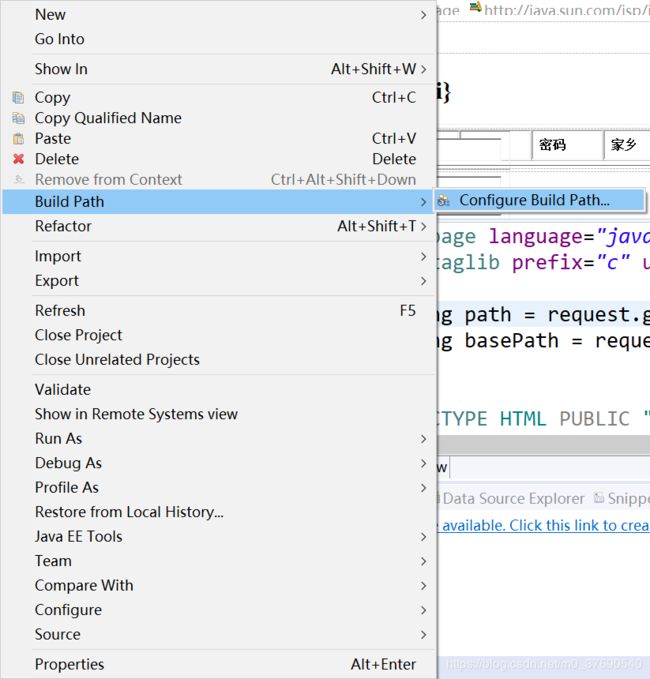
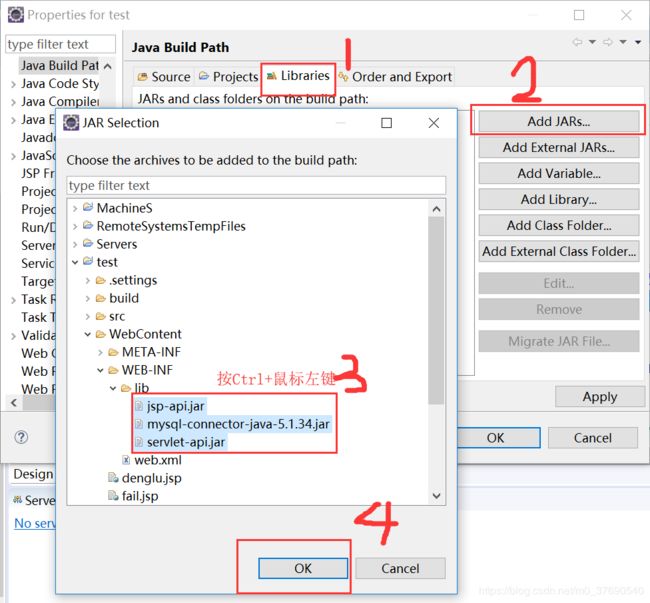
4. 建立对应的包结构
com.filter //过滤器 解决中文字符集乱码
com.util //数据库连接工具类
com.entity //实体类
com.dao //数据操作类
com.servlet //servlet类
建立时遇到5个包不在同一个目录下,可以按F5键进行刷新即可。(也有部分win10按 fn + F5 )
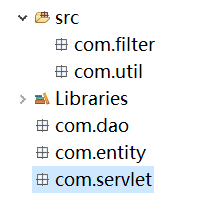
正确src目录如下:
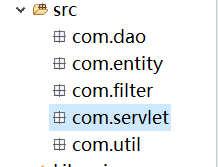
5. 在filter下新建一个EncodingFilter用来解决中文字符集乱码,它需要实现Filter接口,并重写doFilter函数。
package com.filter;
import java.io.IOException;
import javax.servlet.Filter;
import javax.servlet.FilterChain;
import javax.servlet.FilterConfig;
import javax.servlet.ServletException;
import javax.servlet.ServletRequest;
import javax.servlet.ServletResponse;
public class EncodingFilter implements Filter{
public EncodingFilter(){
System.out.println("过滤器构造");
}
public void destroy() {
System.out.println("过滤器销毁");
}
public void doFilter(ServletRequest request, ServletResponse response,FilterChain chain) throws IOException, ServletException {
request.setCharacterEncoding("utf-8"); //将编码改为utf-8
response.setContentType("text/html;charset=utf-8");
chain.doFilter(request, response);
}
public void init(FilterConfig arg0) throws ServletException {
System.out.println("过滤器初始化");
}
}
6. 到web.xml下进行对EncodingFilter相应的配置
<web-app version="2.5"
xmlns="http://java.sun.com/xml/ns/javaee"
xmlns:xsi="http://www.w3.org/2001/XMLSchema-instance"
xsi:schemaLocation="http://java.sun.com/xml/ns/javaee
http://java.sun.com/xml/ns/javaee/web-app_2_5.xsd">
<display-name>testdisplay-name>
<filter>
<filter-name>EncodingFilterfilter-name>
<filter-class>com.filter.EncodingFilterfilter-class>
filter>
<filter-mapping>
<filter-name>EncodingFilterfilter-name>
<url-pattern>/*url-pattern>
filter-mapping>
<welcome-file-list>
<welcome-file>denglu.jspwelcome-file>
welcome-file-list>
web-app>
7. 在util下新建一个DBconn类用来处理对数据库的连接操作
说明:用户名或密码按照自己的数据库更改
package com.util;
import java.sql.*;
public class DBconn {
//jdbc:mysql://localhost:3306/数据库名?useunicuee=true& characterEncoding=utf8
//添加useunicuee=true& characterEncoding=utf8的作用是:指定字符的编码、解码格式。
static String url = "jdbc:mysql://localhost:3306/test?useunicuee=true& characterEncoding=utf8";
static String username = "root"; //默认用户名
static String password = "123"; //连接密码
static Connection conn = null;
static ResultSet rs = null;
static PreparedStatement ps =null;
public static void init(){
try {
Class.forName("com.mysql.jdbc.Driver");
conn = DriverManager.getConnection(url,username,password);
} catch (Exception e) {
System.out.println("init [SQL驱动程序初始化失败!]");
e.printStackTrace();
}
}
public static int addUpdDel(String sql){
int i = 0;
try {
PreparedStatement ps = conn.prepareStatement(sql);
i = ps.executeUpdate();
} catch (SQLException e) {
System.out.println("sql数据库增删改异常");
e.printStackTrace();
}
return i;
}
public static ResultSet selectSql(String sql){
try {
ps = conn.prepareStatement(sql);
rs = ps.executeQuery(sql);
} catch (SQLException e) {
System.out.println("sql数据库查询异常");
e.printStackTrace();
}
return rs;
}
public static void closeConn(){
try {
conn.close();
} catch (SQLException e) {
System.out.println("sql数据库关闭异常");
e.printStackTrace();
}
}
}
8. 在entity下新建一个User实体类
说明:实体即抽象出来的用户对象,对应数据库中的user表,表中每个字段在实体中为一个属性,也可以理解为一个User对象对应数据库中的user表一条记录
package com.entity;
public class User {
private int id;
private String name;
private String pwd;
private String sex;
private String home;
private String info;
public int getId() {
return id;
}
public void setId(int id) {
this.id = id;
}
public String getName() {
return name;
}
public void setName(String name) {
this.name = name;
}
public String getPwd() {
return pwd;
}
public void setPwd(String pwd) {
this.pwd = pwd;
}
public String getSex() {
return sex;
}
public void setSex(String sex) {
this.sex = sex;
}
public String getHome() {
return home;
}
public void setHome(String home) {
this.home = home;
}
public String getInfo() {
return info;
}
public void setInfo(String info) {
this.info = info;
}
}
9. 在dao下新建一个UserDao接口,以及对应的方法实现类
说明:使用接口类是为了规范开发
UserDao.java
package com.dao;
import java.util.List;
import com.entity.User;
public interface UserDao {
//登录
public boolean login(String name,String pwd);
//注册
public boolean register(User user);
//返回用户信息集合
public List<User> getUserAll();
//根据id删除用户
public boolean delete(int id) ;
//更新用户信息
public boolean update(int id,String name, String pwd,String sex, String home,String info) ;
}
新建UserDaoImpl.java ,实现UserDao接口,及未实现的方法。
注意:SQL语句建议在MySQL中测试以下,没有问题然后在拿到实现类中使用,可以避免无必要的麻烦。
package com.dao;
import java.sql.ResultSet;
import java.sql.SQLException;
import java.util.ArrayList;
import java.util.List;
import com.entity.User;
import com.util.DBconn;
public class UserDaoImpl implements UserDao{
//插入
public boolean register(User user) {
boolean flag = false;
DBconn.init();
int i =DBconn.addUpdDel("insert into user(name,pwd,sex,home,info) " +
"values('"+user.getName()+"','"+user.getPwd()+"','"+user.getSex()+"','"+user.getHome()+"','"+user.getInfo()+"')");
if(i>0){
flag = true;
}
DBconn.closeConn();
return flag;
}
//登陆验证
public boolean login(String name, String pwd) {
boolean flag = false;
try {
DBconn.init();
ResultSet rs = DBconn.selectSql("select * from user where name='"+name+"' and pwd='"+pwd+"'");
while(rs.next()){
if(rs.getString("name").equals(name) && rs.getString("pwd").equals(pwd)){
flag = true;
}
}
DBconn.closeConn();
} catch (SQLException e) {
e.printStackTrace();
}
return flag;
}
//查询
public List<User> getUserAll() {
List<User> list = new ArrayList<User>();
try {
DBconn.init();
ResultSet rs = DBconn.selectSql("select * from user");
while(rs.next()){
User user = new User();
user.setId(rs.getInt("id"));
user.setName(rs.getString("name"));
user.setPwd(rs.getString("pwd"));
user.setSex(rs.getString("sex"));
user.setHome(rs.getString("home"));
user.setInfo(rs.getString("info"));
list.add(user);
}
DBconn.closeConn();
return list;
} catch (SQLException e) {
e.printStackTrace();
}
return null;
}
//修改
public boolean update(int id,String name, String pwd,String sex, String home,String info) {
boolean flag = false;
DBconn.init();
String sql ="update user set name ='"+name
+"' , pwd ='"+pwd
+"' , sex ='"+sex
+"' , home ='"+home
+"' , info ='"+info+"' where id = "+id;
int i =DBconn.addUpdDel(sql);
if(i>0){
flag = true;
}
DBconn.closeConn();
return flag;
}
//删除
public boolean delete(int id) {
boolean flag = false;
DBconn.init();
String sql = "delete from user where id="+id;
int i =DBconn.addUpdDel(sql);
if(i>0){
flag = true;
}
DBconn.closeConn();
return flag;
}
}
10.在servlet下创建DengluServlet用来实现对用户登录的操作
说明:
Servlet有两种方式创建,一种手工创建,另一种程序自动生成。
前者自己创建java类,实现Servlet具体内容,然后需要去WEB_INF下的web.xml去配置servlet。
而后者则直接由程序替我们配置好了Servlet)。
本例子使用第二种方式生成Servlet。
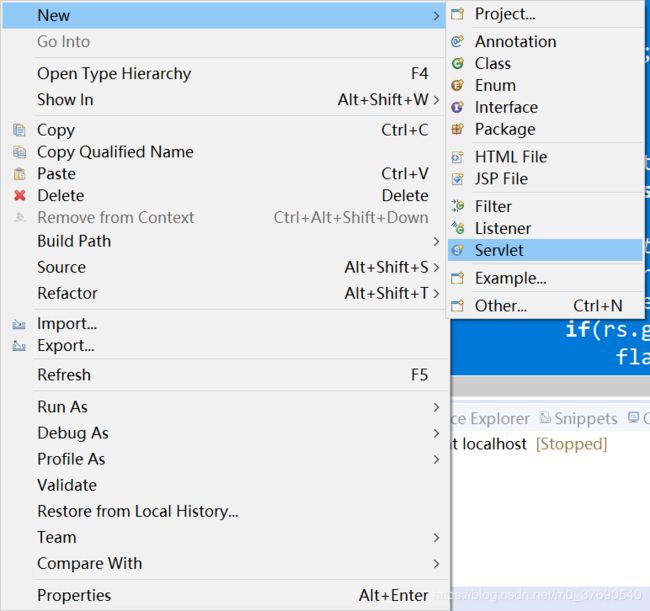
package com.servlet;
import java.io.IOException;
import java.io.PrintWriter;
import javax.servlet.ServletException;
import javax.servlet.http.HttpServlet;
import javax.servlet.http.HttpServletRequest;
import javax.servlet.http.HttpServletResponse;
import com.dao.UserDao;
import com.dao.UserDaoImpl;
public class DengluServlet extends HttpServlet { //需要继承HttpServlet 并重写doGet doPost方法
public void doGet(HttpServletRequest request, HttpServletResponse response)
throws ServletException, IOException {
doPost(request, response); //将信息使用doPost方法执行 对应jsp页面中的form表单中的method
}
public void doPost(HttpServletRequest request, HttpServletResponse response)
throws ServletException, IOException {
String name = request.getParameter("name"); //得到jsp页面传过来的参数
String pwd = request.getParameter("pwd");
UserDao ud = new UserDaoImpl();
if(ud.login(name, pwd)){
request.setAttribute("xiaoxi", "欢迎用户"+name); //向request域中放置信息
request.getRequestDispatcher("/success.jsp").forward(request, response);//转发到成功页面
}else{
response.sendRedirect("fail.jsp"); //重定向到首页
}
}
}
有两点要注意的地方:
1:getParameter与getAttribute两者的区别
request.setAttribute(“xiaoxi”, “欢迎用户”+name);//向request域中放置信息 ( 键值对的形式) 名字为xiaoxi 内容为"欢迎用户"+name
request.getAttribute(“xiaoxi”);//得到request域中放置名字为xiaoxi的信息
request.getParameter(“name”);//得到request域的参数信息(得到jsp页面传过来的参数)
getAttribute表示从request范围取得设置的属性,必须要先setAttribute设置属性,才能通过getAttribute来取得,设置与取得的为Object对象类型 。
getParameter表示接收参数,参数为页面提交的参数,包括:表单提交的参数、URL重写(就是xxx?id=1中的id)传的参数等,因此这个并没有设置参数的方法(没有setParameter),而且接收参数返回的不是Object,而是String类型
2:转发与重定向的区别
(1).重定向的执行过程:Web服务器向浏览器发送一个http响应–》浏览器接受此响应后再发送一个新的http请求到服务器–》服务器根据此请求寻找资源并发送给浏览器。它可以重定向到任意URL,不能共享request范围内的数据。
(2).重定向是在客户端发挥作用,通过新的地址实现页面转向。
(3).重定向是通过浏览器重新请求地址,在地址栏中可以显示转向后的地址。
(4).转发过程:Web服务器调用内部方法在容器内部完成请求和转发动作–》将目标资源发送给浏览器,它只能在同一个Web应用中使用,可以共享request范围内的数据。
(5).转发是在服务器端发挥作用,通过forward()方法将提交信息在多个页面间进行传递。
(6).转发是在服务器内部控制权的转移,客户端浏览器的地址栏不会显示出转向后的地址。
11. 在servlet下创建一个ZhuceServlet用来实现用户注册的操作
ZhuceServlet.java
package com.servlet;
import java.io.IOException;
import java.io.PrintWriter;
import javax.servlet.ServletException;
import javax.servlet.http.HttpServlet;
import javax.servlet.http.HttpServletRequest;
import javax.servlet.http.HttpServletResponse;
import com.dao.UserDao;
import com.dao.UserDaoImpl;
import com.entity.User;
public class ZhuceServlet extends HttpServlet {
public void doGet(HttpServletRequest request, HttpServletResponse response)
throws ServletException, IOException {
doPost(request, response);
}
public void doPost(HttpServletRequest request, HttpServletResponse response)
throws ServletException, IOException {
String name = request.getParameter("name"); //获取jsp页面传过来的参数
String pwd = request.getParameter("pwd");
String sex = request.getParameter("sex");
String home = request.getParameter("home");
String info = request.getParameter("info");
User user = new User(); //实例化一个对象,组装属性
user.setName(name);
user.setPwd(pwd);
user.setSex(sex);
user.setHome(home);
user.setInfo(info);
UserDao ud = new UserDaoImpl();
if(ud.register(user)){
request.setAttribute("username", name); //向request域中放置参数
//request.setAttribute("xiaoxi", "注册成功");
request.getRequestDispatcher("/denglu.jsp").forward(request, response); //转发到登录页面
}else{
response.sendRedirect("fail.jsp");//重定向到首页
}
}
}
12. 在servlet下创建SearchallServlet用来返回数据库中所有用户信息
SearchallServlet.java
package com.servlet;
import java.io.IOException;
import java.io.PrintWriter;
import java.util.List;
import javax.servlet.ServletException;
import javax.servlet.http.HttpServlet;
import javax.servlet.http.HttpServletRequest;
import javax.servlet.http.HttpServletResponse;
import com.dao.UserDao;
import com.dao.UserDaoImpl;
import com.entity.User;
public class SearchallServlet extends HttpServlet {
public void doGet(HttpServletRequest request, HttpServletResponse response)
throws ServletException, IOException {
doPost(request, response);
}
public void doPost(HttpServletRequest request, HttpServletResponse response)
throws ServletException, IOException {
UserDao ud = new UserDaoImpl();
List<User> userAll = ud.getUserAll();
request.setAttribute("userAll", userAll);
request.getRequestDispatcher("/showall.jsp").forward(request, response);
}
}
13. 在servlet下创建DeleteServlet用来删除用户操作
DeleteServlet.java
package com.servlet;
import java.io.IOException;
import java.io.PrintWriter;
import javax.servlet.ServletException;
import javax.servlet.http.HttpServlet;
import javax.servlet.http.HttpServletRequest;
import javax.servlet.http.HttpServletResponse;
import com.dao.UserDao;
import com.dao.UserDaoImpl;
public class DeleteServlet extends HttpServlet {
public void doGet(HttpServletRequest request, HttpServletResponse response)
throws ServletException, IOException {
doPost(request, response);
}
public void doPost(HttpServletRequest request, HttpServletResponse response)
throws ServletException, IOException {
String id = request.getParameter("id");
int userId = Integer.parseInt(id);
UserDao ud = new UserDaoImpl();
if(ud.delete(userId)){
request.setAttribute("xiaoxi", "删除成功");
request.getRequestDispatcher("/SearchallServlet").forward(request, response);
}else{
response.sendRedirect("fail.jsp");
}
}
}
14. 在servlet下创建UpdateServlet操作用来更新用户信息
UpdateServlet.java
package com.servlet;
import java.io.IOException;
import java.io.PrintWriter;
import javax.servlet.ServletException;
import javax.servlet.http.HttpServlet;
import javax.servlet.http.HttpServletRequest;
import javax.servlet.http.HttpServletResponse;
import com.dao.UserDao;
import com.dao.UserDaoImpl;
import com.entity.User;
public class UpdateServlet extends HttpServlet {
public void doGet(HttpServletRequest request, HttpServletResponse response)
throws ServletException, IOException {
doPost(request, response);
}
public void doPost(HttpServletRequest request, HttpServletResponse response)
throws ServletException, IOException {
String id = request.getParameter("id");
int userId = Integer.parseInt(id);
String name = request.getParameter("name");
String pwd = request.getParameter("pwd");
String sex = request.getParameter("sex");
String home = request.getParameter("home");
String info = request.getParameter("info");
System.out.println("------------------------------------"+userId);
UserDao ud = new UserDaoImpl();
if(ud.update(userId, name, pwd, sex, home, info)){
request.setAttribute("xiaoxi", "更新成功");
request.getRequestDispatcher("/SearchallServlet").forward(request, response);
}else{
response.sendRedirect("fail.jsp");
}
}
}
15. 配置servlet
注意:如果非手打而用Eclipse生成则不用配置
附完整web.xml
<web-app version="2.5"
xmlns="http://java.sun.com/xml/ns/javaee"
xmlns:xsi="http://www.w3.org/2001/XMLSchema-instance"
xsi:schemaLocation="http://java.sun.com/xml/ns/javaee
http://java.sun.com/xml/ns/javaee/web-app_2_5.xsd">
<display-name>testdisplay-name>
<filter>
<filter-name>EncodingFilterfilter-name>
<filter-class>com.filter.EncodingFilterfilter-class>
filter>
<filter-mapping>
<filter-name>EncodingFilterfilter-name>
<url-pattern>/*url-pattern>
filter-mapping>
<servlet>
<servlet-name>DengluServletservlet-name>
<servlet-class>com.servlet.DengluServletservlet-class>
servlet>
<servlet>
<servlet-name>ZhuceServletservlet-name>
<servlet-class>com.servlet.ZhuceServletservlet-class>
servlet>
<servlet>
<servlet-name>SearchallServletservlet-name>
<servlet-class>com.servlet.SearchallServletservlet-class>
servlet>
<servlet>
<servlet-name>DeleteServletservlet-name>
<servlet-class>com.servlet.DeleteServletservlet-class>
servlet>
<servlet>
<servlet-name>UpdateServletservlet-name>
<servlet-class>com.servlet.UpdateServletservlet-class>
servlet>
<servlet-mapping>
<servlet-name>DengluServletservlet-name>
<url-pattern>/DengluServleturl-pattern>
servlet-mapping>
<servlet-mapping>
<servlet-name>ZhuceServletservlet-name>
<url-pattern>/ZhuceServleturl-pattern>
servlet-mapping>
<servlet-mapping>
<servlet-name>SearchallServletservlet-name>
<url-pattern>/SearchallServleturl-pattern>
servlet-mapping>
<servlet-mapping>
<servlet-name>DeleteServletservlet-name>
<url-pattern>/DeleteServleturl-pattern>
servlet-mapping>
<servlet-mapping>
<servlet-name>UpdateServletservlet-name>
<url-pattern>/UpdateServleturl-pattern>
servlet-mapping>
web-app>
16. 新建jsp页面
说明:denglu.jsp 用户登录页面
默认页面进入项目后 先进入该页面(web.xml中配置)
form表单中需要注意的是
其中action即为要跳转的servlet路径(即在web.xml中配置的servlet-mapping :
method="post"为传递值得方法类型有两种,第一种get,第二种post。网上介绍这两种的区别有很多,阐述的又是百家争鸣。而我觉得那个方便就用那个,一般使用post传递,可避免乱码。
另一个需要注意的是 用户名: input标签 一定要起个名字 如name="name"
起名的作用就是让后台通过request.getParterment("name");来取值
<%@ page language="java" import="java.util.*" pageEncoding="utf-8"%>
<html>
<head>
<title>登陆注册页面title>
head>
<body >
<form action="DengluServlet" method="post" style="padding-top:-700px;">
用户名:<br><br>
密码: <br><br>
<br>
form>
<form action="zhuce.jsp">
form>
body>
html>
zhuce.jsp 用户注册页面
点击“用户注册”按钮,跳转到用户注册页面
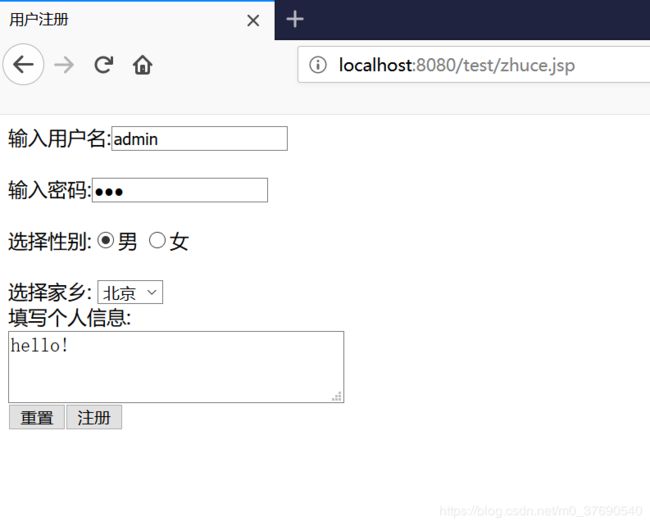
<%@ page language="java" import="java.util.*" pageEncoding="utf-8"%>
<%
String path = request.getContextPath();
String basePath = request.getScheme()+"://"+request.getServerName()+":"+request.getServerPort()+path+"/";
%>
<html>
<head>
<title>用户注册title>
head>
<body >

